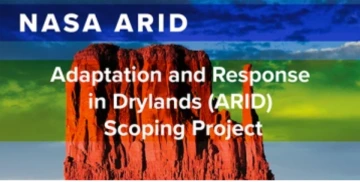Bringing Drylands into Focus
ARID Project Aims to Advance NASA’s Earth Science Goals

Our scientific understanding of drylands—ecosystems that cover 40% of Earth’s land surface—could be likened to a nearsighted person squinting. The Adaptation and Response in Drylands (ARID) project, a proposal to NASA led by a team including multiple University of Arizona scientists, intends to bring these vital landscapes into sharper focus.
—Tucson, AZ—
Our scientific understanding of drylands—ecosystems that cover 40% of Earth’s land surface—could be likened to a nearsighted person squinting. The Adaptation and Response in Drylands (ARID) project, a proposal to NASA led by a team including multiple University of Arizona scientists, intends to bring these vital landscapes into sharper focus.
ARID is one of only two projects that were invited to scope out a full project report under NASA’s Terrestrial Ecology program. If approved, the ARID campaign could span 10 years, potentially bringing upwards of $100 million in funding to the dryland community. The university could serve as the project’s headquarters, leveraging its deep expertise and existing resources such as Grass-Cast Southwest, a state-of-the-art rangeland productivity forecast tool used for decision support by regional ranchers and rangeland managers. “This project would further establish the University of Arizona as a global hub for dryland research,” said Dave Moore, professor and program chair of Watershed Management and Ecohydrology.

As part of the scoping study, the ARID team conducted over 150 meetings with stakeholders, including scientists, land managers and data users from federal agencies such as the Bureau of Land Management (BLM), U.S. Department of Agriculture (USDA) and U.S. Geological Survey (USGS). The study also engaged Indigenous Nations, local communities, and international collaborators in regions spanning the western United States, Mexico, South America, Australia and Africa.
Emerging from the scoping study, ARID’s innovative and ambitious technical approach combines data from experimental sites, tower sensor networks, uncrewed aerial systems (UASs), aircraft campaigns and satellites to capture a multi-scale view of dryland ecosystems. This comprehensive remote sensing strategy enhances NASA’s existing capabilities and lays the groundwork for developing new tools tailored to dryland monitoring.
“Drylands are not wastelands,” emphasized Flurin Babst, an assistant professor at the U of A in the School of Natural Resources and the Environment. “They are vital ecosystems contributing to global food security, carbon storage, and biodiversity. With ARID, we can give these landscapes the attention they deserve and uncover the mechanisms driving their responses to change.”
ARID carries significant political and strategic potential. The initiative seeks to reshape the narrative surrounding drylands in federal policy discussions, emphasizing their value as ecosystems integral to food production and other vital human activities on a rapidly changing planet. “We need to frame drylands as critical to thriving societies,” said Bill Smith, U of A associate professor in the School of Natural Resources and the Environment and member of the Earth Dynamics Observatory. “By aligning scientific innovation with effective advocacy, ARID can demonstrate the tangible benefits of investing in dryland research.”
To share its progress and invite further input, the ARID team will host a Town Hall at the American Geophysical Union (AGU) Fall Meeting, scheduled for Dec. 9–13, 2024, in Washington, D.C.
For more information and updates on ARID, please visit https://aridscoping.arizona.edu/
